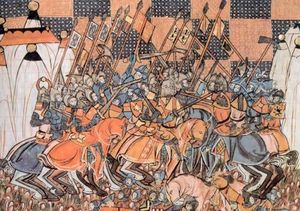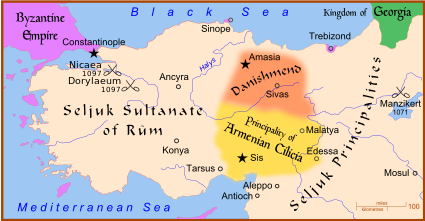معركة دوريلايوم (1097)
| ||||||||||||||||||||||||||||||||
معركة دوريلايوم Battle of Dorylaeum أخذت معركة دوريلايوم مكان أثناء الحملة الصليبية الأولى في 1 يوليو 1097، بين الصليبيين والأتراك السلاجقة، بالقرب من مدينة دوريلايوم في الأناضول.
. . . . . . . . . . . . . . . . . . . . . . . . . . . . . . . . . . . . . . . . . . . . . . . . . . . . . . . . . . . . . . . . . . . . . . . . . . . . . . . . . . . . . . . . . . . . . . . . . . . . . . . . . . . . . . . . . . . . . . . . . . . . . . . . . . . . . . . . . . . . . . . . . . . . . . . . . . . . . . . . . . . . . . . .
المعركة
عبرت الجيوش الصليبية البالغ عددها نحو ثلاثين ألفاً مضيقي البسفور في عام 1079، وكانت لا تزال موزعة القيادة. وكان من حسن حظ الصليبيين أن المسلمين كانوا أشد انقساماً على أنفسهم من المسيحيين، فقد أنهكت الحروب قوة المسلمين في أسبانيا، ومزقت المنازعات الدينية وحدتهم في شمالي إفريقيا؛ وكان الخلفاء الفاطميون في الشرق يمتلكون بلاد الشام الجنوبية، بينما كان أعداؤهم السلاجقة يمتلكون جزأها الشمالي والقسم الأكبر من آسيا الصغرى. وخرجت أرمينيا على فاتحيها السلاجقة وتحالفت مع الفرنجة. وزحفت جيوش أوربا يؤيدها هذا العون كله وحاصرت نيقية. واستسلمت الحامية التركية في المدينة بعد أن وعدها ألكسيوس بالمحافظة على حياتها (19 يونية سنة 1097)، ورفع إمبراطور الروم العلم الإمبراطوري على حصنها، وحمى المدينة من النهب، وأرضى الزعماء الإقطاعيين بالعطايا السخية، ولكن الجنود المسيحيين اتهموا ألكسيوس بأنه ضالع مع الأتراك. واستراح الصليبيون في المدينة أسبوعاً زحفوا بعده على أنطاكية، والتقوا عند دوريليوم بجيش تركي تحت قيادة قلج أرسلان، وانتصروا عليه انتصاراً سفكوا فيه كثيراً من الدماء (أول يولية سنة 1097)، واخترقوا آسيا الصغرى دون أن يلقوا فيها عدواً غير قلة الماء والطعام، والحر الشديد الذي لم تكن دماء الغربيين قادرة على احتماله. ومات الرجال والنساء، والخيل والكلاب، من العطش في أثناء هذا الزحف الشاق الذي اجتازوا فيه خمسمائة ميل؛ فلما عبروا جبال طوروس انفصل بعض النبلاء بقواتهم عن الجيش الرئيسي ليفتحوا لأنفسهم فتوحاً خاصة بهم- فسار ريمند، وبوهمند، وجدفري إلى أرمينيا؛ وسار تنكرد وبولدوين (أخو جدفري) إلى الرها حيث أسس بلدوين بالختل والغدر(14) أولى الإمارات اللاتينية في الشرق (1098). وأخذت قوات الصليبيين الكبرى تشكو من هذا التأخير وتتوجس منه الشر المستطير؛ فعاد النبلاء وواصلت القوة بأجمعها الزحف على أنطاكية.
On July 1, Bohemund's force was surrounded outside Dorylaeum by Kilij Arslan. Godfrey and Raymond had separated from the vanguard at Leuce, and the Turkish army attacked at dawn, taking Bohemund's army (not expecting such a swift attack) entirely by surprise, shooting arrows into the camp. Bohemund's knights had quickly mounted but their sporadic counterattacks were unable to deter the Turks. The Turks were riding into camp, cutting down noncombatants and unarmoured foot soldiers, who were unable to outrun the Turkish horses and were too disoriented and panic-stricken to form lines of battle. To protect the unarmoured foot and noncombatants, Bohemond ordered his knights to dismount and form a defensive line, and with some trouble gathered the foot soldiers and the noncombatants into the centre of the camp; the women acted as water-carriers throughout the battle. While this formed a battle line and sheltered the more vulnerable men-at-arms and noncombatants, it also gave the Turks free rein to maneuver on the battlefield. The Turkish mounted archers attacked in their usual style - charging in, shooting their arrows, and quickly retreating before the crusaders could counterattack. The archers did little damage to the heavily armoured knights, but they inflicted heavy casualties on the horses and unarmoured foot soldiers. Bohemond had sent messengers to the other Crusader army and now struggled to hold on until help arrived, and his army was being forced back to the bank of the Thymbris river. The marshy riverbanks protected the Crusaders from mounted charge, as the ground was too soft for horses, and the armoured knights formed a circle protecting the foot soldiers and noncombatants from arrows, but the Turks kept their archers constantly supplied and the sheer number of arrows was taking its toll, reportedly more than 2,000 falling to horse-archers. Bohemund's knights were impetuous - although ordered to stand ground, small groups of knights would periodically break ranks and charge, only to be slaughtered or forced back as the Turkish horses fell back beyond range of their swords and arrows, while still shooting at them with arrows, killing many of the knights' horses out from under them. And although the knights' armour protected them well (the Turks called them 'men of iron') the sheer number of arrows meant that some would find unprotected spots and eventually, after so many hits, a knight would collapse from his wounds.
ملاحظات
- ^ أ ب ت John France, The Crusades And The Expansion Of Catholic Christendom, 1000-1714, p. 71 "[...]The result was a gap of about 5 kilometres between the vanguard, consisting of the armies of Bohemond, Robert of Normandy and Stephen of Blois about 20,000 strong, and the main force of about 30,000. They were aware of that Kilij Arslan was about: he had returned to the fray after the defeat of Nicaea, with an army of 6,000-7,000 mounted man, including his new allies, the Danishmend Turks."
- ^ Bennett, The Hutchinson Dictionary of Ancient & Medieval Warfare, p. 103 "Following their successful siege of Nicaea in 1097, the crusaders split into two columns to aid foraging. The vanguard under Bohemond was attacked at Bozüyük. Sultan Kilij Arslan led 7,000-8,000 Seljuk mounted archers in an ambush, throwing the crusaders into confusion."
- ^ أ ب John France, Victory in the East, p. 181 "Casualties appear to have been heavy although how far we can regard Albert's 4,000 Christians and 3,000 Turks as precise figures is a different matter."
مراجع
- Albert of Aix, Historia Hierosolymitana
- Fulcher of Chartres, Historia Hierosolymitana
- Gesta Francorum
- Hans E. Mayer, The Crusades. Oxford, 1965.
- Raymond of Aguilers, Historia francorum qui ceperunt Jerusalem
- Jonathan Riley-Smith, The First Crusade and the Idea of Crusading. Philadelphia, 1999.
- Steven Runciman, The First Crusaders, 1095-1131. Cambridge University Press, 1951.
- Kenneth Setton, ed., A History of the Crusades. Madison, 1969-1989.(available online).
- John France, Victory in the East: A Military History of the First Crusade, Cambridge University Press, 1996.
- John France, The Crusades And The Expansion Of Catholic Christendom, 1000-1714, Routledge, 2005.
- Matthew Bennett, The Hutchinson Dictionary of Ancient & Medieval Warfare, Helicon Publishing Ltd, 1998.

